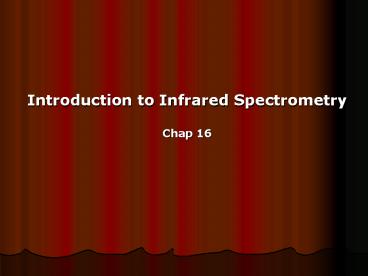Introduction to Infrared Spectrometry Chap 16 - PowerPoint PPT Presentation
1 / 29
Title:
Introduction to Infrared Spectrometry Chap 16
Description:
Interferometer: Splits beam equally in power. Recombines them such that variations ... Michelson Interferometer. Fig. 7-43 (p 208) ... – PowerPoint PPT presentation
Number of Views:141
Avg rating:3.0/5.0
Title: Introduction to Infrared Spectrometry Chap 16
1
Introduction to Infrared SpectrometryChap 16
2
- Quantum Mechanical Treatment of Vibrations
- Required to include quantized nature of E
- From solving the wave equations of QM
Selection rule for vib. transitions
3
Quantum Mechanical Treatment of Vibrations
- Plot of potential energy
- where level spacings
hvres
- All vib levels spaced
- equally for HO only
Interatomic distance, r ?
4
- Problems with Harmonic Oscillator (HO) Model
- Real vib levels coalesce as v levels increase
- Does not allow for dissociation of bond
- Repulsion is steeper at small r
- Appears as if atoms can pass through
- each other during vibrational amplitude
Solution
Anharmonic Oscillator (AHO)
5
Anharmonic Oscillator (AHO)
Fig. 16-3
6
Anharmonic Oscillator (AHO)
- Three consequences
- (1) Harmonic at low v levels
- (2) ?E becomes smaller at high v levels
- (3) Selections rule fails ?v 1 and 2...
- referred to as overtones
7
Vibrational Modes
- Approach
- Each atom in a molecule can be located
- with three coordinates (degrees of freedom)
- A molecule with N atoms then has 3N DOF
- Translational motion defined by center-of-
- mass coordinates (COM)
8
- Linear Molecules
- 3 DOF to define translation
- 2 DOF to define rotation
- 3N 5 number of vibrational modes
- Nonlinear Molecules
- 3 DOF to define translation
- 3 DOF to define rotation
- 3N 6 number of vibrational modes
9
Examples N2 CO2 H2O CH3-C(O)-CH3
10
Vibrations of CO2
Fig 16-10
667 cm-1
2350 cm-1
1388 cm-1
Doubly degenerate
No dipole change
Dipole change
Dipole change
11
Vibrations of H2O
3657 cm-1
1595 cm-1
3766 cm-1
12
IR Sources and Transducers
Sources
(1200 2200 K)
13
Spectral emission from a Nernst glower at 2200
K
Fig 16-16
14
IR Sources and Transducers
Sources
(1200 2200 K)
15
Transducers
- IR beam 10-7 - 10-9 W, ?T at transducer mK-µK
16
IR Instrumentation
Dispersive Grating IR Instruments
Fig 16-11
17
IR Instrumentation
- Dispersive Grating IR Instruments
- Similar to UV-Vis spectrophotometer
- BUT sample after source and before
monochromator in IR - Sample after monochromator in UV- Vis - less
incident light - Grating 10-500 blazes per mm
- Single beam and double beam (DB in time and
space) - DB eliminates atmospheric gas interference
18
Single- and Double-Beam Spectra of the Atmosphere
Fig. 16-9
19
- Fourier Transform IR Instruments
- FTIR has largely displaced dispersive IRs
- A multiplex instrument (e.g., diode array)
- Beam is split and pathlength is varied
- to produce interference patterns
- Signal converted from frequency
- domain to time domain
- Fourier transform then converts clean
- signal back to frequency domain
20
- Fourier Transform Instruments (Section 7-I) have
two advantages - Throughput (or Jaquinot) advantage
- Few optics, no slits, high intensity
- Usually, to improve resolution, decrease slit
width but less light makes spectrum "noisier" - i.e., signal-to-noise ratio (S/N) decreases (p.
110-111)
21
S/N improves with more scans (noise is random,
signal is not!)
Fig. 5-10
22
- (2) Multiplex (or Fellget) advantage
- Simultaneously measure entire spectrum
Components of Fourier Transform Instruments
- Based on Michelson Interferometer
- Converts frequency signal to time signal
23
Fig. 7-41 (p 207)
Time domain
Frequency domain
24
Time Domain Signal of a Source Made Up of Many
Wavelengths
Fig. 7-42 (p 207)
25
- Frequencies of IR photons 100 THz
- No detector can respond on 10-14 s time scale
- Need to modulate high freq signal ? lower freq
- without loss of P(t) relationships
- Interferometer
- Splits beam equally in power
- Recombines them such that variations
- in power can be measured as P(d)
- d retardation, difference in pathlengths
- of the two beams
26
Michelson Interferometer Fig. 7-43 (p 208)
Single Frequency Source
27
Computer needed to turn complex interferogram
into spectrum
Fig. 7-43 (p 188)
Single Frequency
28
Two Frequencies
Many Frequencies
29
Advantages to FT Instruments
- High S/N ratios - high throughput
- Rapid (lt10 s)
- Reproducible
- High resolution (lt0.1 cm-1)
- Inexpensive (relatively!)































